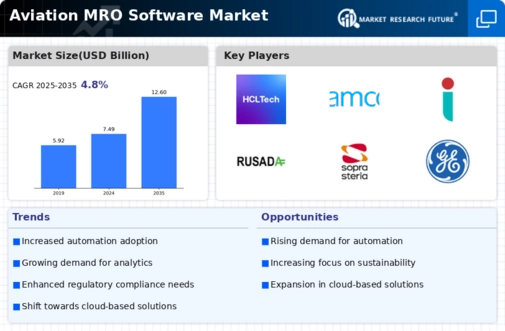Top Industry Leaders in the Aviation MRO Software Market

Key Players and Market Leaders:
IBS Software (India)
Flatirons Solutions, Inc. (US)
Rusada (Switzerland)
Sopra Steria (France)
Communications Software Limited (UK)
Aviation Intertec Services (Canada)
GE Aviation (US)
BytzSoft Technologies Pvt. Ltd. (India)
Lufthansa Technik AG (Germany)
Tracware Limited (UK)
Aerosoft Systems Inc. (US)
FLY Online Tools (US)
Strategies Adopted:
The strategies adopted by key players in the Aviation MRO Software market are diverse, reflecting the multifaceted nature of the industry. Collaborations and partnerships are prevalent, with companies seeking to integrate their software solutions with other aviation systems to provide seamless end-to-end solutions. Additionally, mergers and acquisitions play a significant role, allowing companies to expand their product portfolios and geographic reach. Strategic investments in artificial intelligence, machine learning, and data analytics are becoming increasingly common to enhance the predictive maintenance capabilities of MRO software.
Factors for Market Share Analysis:
Market share analysis in the Aviation MRO Software sector is influenced by several key factors. The ability to offer comprehensive solutions that cover various aspects of MRO activities, including maintenance planning, inventory management, and regulatory compliance, is a critical determinant. Moreover, companies that can adapt their solutions to the evolving regulatory landscape and industry standards tend to gain a competitive advantage. Customer satisfaction, timely updates, and strong customer support also contribute significantly to market share, as clients seek reliable and responsive partners in the dynamic aviation environment.
New and Emerging Companies:
The Aviation MRO Software market is witnessing the emergence of innovative startups that are disrupting the traditional landscape with novel solutions. Companies like FlyPal, Rusada, and Traxxall are gaining traction by offering specialized MRO software with a focus on user-friendly interfaces, scalability, and flexibility. These newcomers leverage cloud-based technologies, mobile applications, and advanced analytics to address specific pain points in the MRO process. As these companies continue to grow, they pose a challenge to established players by introducing agile and cost-effective alternatives.
Industry News and Innovations:
Industry news and ongoing innovations are pivotal in shaping the competitive landscape of the Aviation MRO Software market. Continuous advancements in technologies such as blockchain, Internet of Things (IoT), and augmented reality are influencing the market dynamics. For example, the integration of blockchain can enhance the traceability of spare parts, ensuring transparency and authenticity in the supply chain. IoT applications facilitate real-time monitoring of aircraft components, enabling predictive maintenance and reducing downtime. Keeping abreast of these technological trends is crucial for companies aiming to stay competitive in this rapidly evolving space.
Current Company Investment Trends:
Investment trends in the Aviation MRO Software market reflect the industry's recognition of the importance of cutting-edge technologies. Companies are allocating substantial resources to research and development initiatives aimed at enhancing software capabilities. Investments in data security measures are also on the rise, considering the sensitivity of aviation data and the increasing threat landscape. Moreover, strategic investments in global expansion, through acquisitions or establishing regional offices, are common strategies to capture new markets and diversify revenue streams.
Overall Competitive Scenario:
The overall competitive scenario in the Aviation MRO Software market is marked by intense rivalry among key players and a constant influx of new entrants. The market is poised for further evolution as technological advancements, regulatory changes, and industry demands continue to shape the landscape. The ability to innovate, adapt, and provide comprehensive solutions will be crucial for companies to maintain or enhance their market positions. Collaboration and strategic partnerships will remain key strategies to address the diverse needs of the aviation industry and stay ahead in this competitive arena.
The Aviation MRO Software market is a dynamic and competitive space where key players, new entrants, and innovative startups converge to meet the evolving needs of the aviation industry. Strategies adopted by market leaders, market share analysis factors, the emergence of new companies, industry news, and investment trends collectively define the competitive landscape. In this environment, staying abreast of technological trends, regulatory changes, and customer expectations is imperative for companies aiming to thrive in the highly competitive Aviation MRO Software market. As the industry continues to evolve, the landscape is expected to witness further transformations, making it an exciting and challenging arena for both established players and newcomers alike.
Recent Development :
-
Universal Avionics (UA):- Launched ClearVision™ EFVS system with certification for Boeing 737NG aircraft, expanding their reach beyond general aviation.
- Partnered with AerSale for AerAware™ EFVS solution, combining expertise for broader accessibility.
- Focus on next-generation EFVS technologies with enhanced sensor capabilities and AI-powered integration.
-
Elbit Systems:- Increasing focus on commercial aviation through UA and Elbit Systems Aerospace subsidiaries.
- Pioneering multispectral sensors for improved EFVS performance in low-visibility conditions.
- Actively pursuing market expansion in Europe, Asia, and other regions.
-
AerSale:- Achieved 50% visual advantage with AerAware™ EFVS, demonstrating its potential for surpassing human eyesight in certain scenarios.
- Investing in training and certification programs to address regulatory requirements and pilot adoption.
- Collaborating with aircraft manufacturers for EFVS integration into new models.


